How to use heat shrink tubing at home. We are waiting for multilayer heat shrink.
Heat shrinking - simple and effective method insulation of wires and cables. It is used as a more modern and practical replacement for classic electrical tape. Let's figure it outwhat it is and why it is better than classic blue electrical tape.
Heat shrink is a flexible polymer tube that can shrink several times when the temperature rises to 70-130 degrees. The cost of such material is low - 1 meter costs about 0.5 dollars (30 rubles at the 2017 exchange rate).
Heat shrink marking
Heat shrinking has its advantages. These include:
- Easy to install. All you need to do is place the tube on the wire or cable and heat it with a lighter or hair dryer.
- Good insulating properties. As the tube shrinks, it forms an insulating layer 1-4 mm thick, which is quite sufficient for low-current and power cables in domestic conditions.
- UV resistance, long service life. Heat shrinkage does not lose its properties over the course of decades; it is not destroyed by solar radiation and can withstand temperature changes from -40 to +60 degrees.
- Good density and strength, the ability to moisture/waterproof the cable.
- Affordable price, wide range of colors for wire marking.
Shrinkage is available in various colors - black, green, red, yellow, blue, etc. It can even be transparent, which allows you to control the quality of the connection.
Note that markings are very helpful when routing cables - you can combine them into groups and indicate the first and second phase, zero, and create other markings.
Heat shrink characteristics
Today on the market you can find a large number of similar insulators. About that how to use heat shrink tube, We'll talk a little later, but now we'll look at the main characteristics of the material:
- Inner diameter. You need to know in order to carefully place the tube on a wire or cable.
- Compression ratio or shrinkage ratio. Classic heat shrink shrinks 4-6 times (the ratio is indicated in the product labeling as 4:1 or 6:1).
- The presence or absence of an adhesive composition. If the connection is not in any way in contact with moisture (for example, in household appliances), then you can use inexpensive heat shrink without glue. If the cable passes through a damp room or is used in a car, that is, there is a risk of breakdown due to moisture, then it is recommended to use tubes with glue that insulates the connection.
- Type of polymer. Depending on the operating conditions, products made of elastomers, polyvinyl chloride, polyolefins, fluoride polymers, etc. can be used.
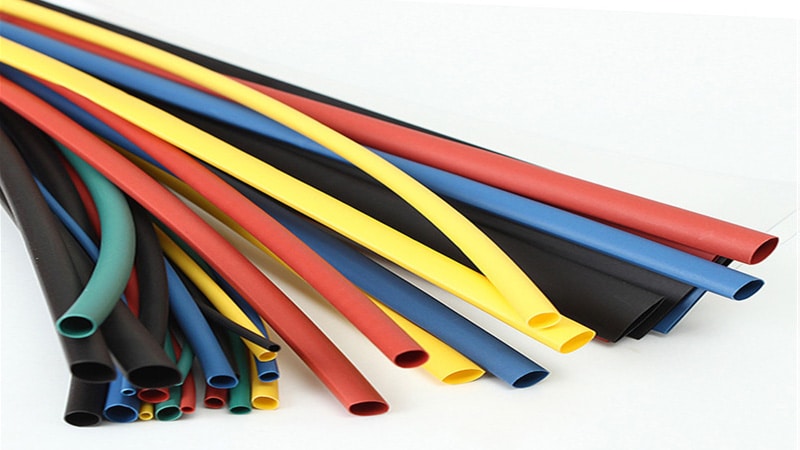 Types of Heat Shrinks
Types of Heat Shrinks Terms of use
Now that you know, let's figure out how to use it correctly. Although manufacturers recommend compressing it using special hair dryer, but the vast majority of electricians and installers use a regular lighter. Using this method is more practical and faster. While a hairdryer should be plugged into an outlet, a lighter allows you to isolate materials even in the middle of an open field.
Attention:for shrinkage, tubes should be used that completely compress the cable within its diameter. For example, if you need to insulate a 4 mm thick wire secured with a 6 mm clip, then you do not need to use heat shrink with an internal diameter of 25 mm, even if it has a compression ratio of 6:1.
We consider: 4*6=24, which is less than the existing diameter, so a tight fit cannot be achieved. In our example, it is better to use an 8-10 mm tube with a ratio of 4:1.
The wires should be connected with a shift relative to each other to avoid short circuit. First, they are disconnected from each other, then cut off and cleaned into desired length, put on the tube and solder it or secure it with a clip. The heat shrink is then placed over the exposed wire. How to heat heat shrink tubing? To do this, you can use a hair dryer, lighter, or burner. The same is done with the second wire, after which the entire insulation is covered with a third layer.
There is no need to heat it too much - the polymer contracts evenly. Increasing the temperature will only lead to charring or spoilage. The tube should protect the connection on both sides - try to ensure that it overlaps the intact insulation by 2-5 cm. Do not skimp on the material - it is inexpensive.
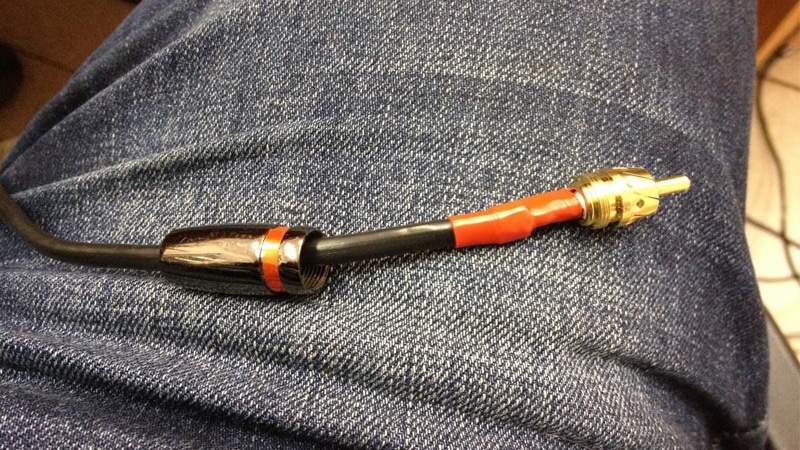 Insulated plug surface
Insulated plug surface Scope of application
So you know - They are used to insulate joints and seams. Let's look at its capabilities in more detail.
One type of heat shrinkage is tubes containing adhesive compounds. Such materials can reliably isolate the connection not only from electrical breakdown, but also from moisture or water. It also gives the structure additional protection and strength.
The method of installing adhesive pipes is no different from the classic ones: it is placed on the surface, taking into account the diameter, and then heated with a lighter, burner or hairdryer. The glue first melts, then the heat shrink fits tightly onto the surface and distributes it evenly over the entire plane. As a result, the cable or pipe is filled with a layer of durable and moisture-resistant glue, and the connection is well sealed.
Use adhesives to protect wires passing through wet areas, for laid in the ground or outdoors. Often heat shrink tubing (HERE) is placed on wooden posts or piles that are buried in the ground. It plays the role of moisture insulation much better than roofing felt and resin, due to complete sealing.
The use of heat-shrinkable tubing is allowed for car repairs - it can be used to insulate brake and fuel hoses (be careful with open flames). Sometimes joints on plumbing fixtures are insulated using an adhesive pipe, but be careful - dismantling it will be difficult. Dried glue is quite difficult to remove.
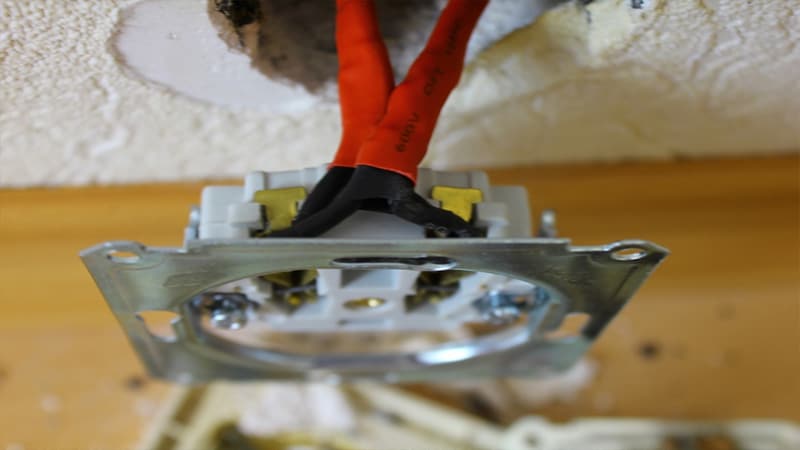 Insulated wires sockets
Insulated wires sockets Non-standard applications
Now you know, what is heat shrink tubing and what it is like. Let's look at a few non-standard options its applications other than electrical insulation:
- Protection of surfaces from damage, corrosion, moisture. When compressed, the material forms a durable layer 1-4 mm thick, which will protect the cable or other object from scratches, abrasion or mechanical impact. HERE can be used for additional protection on corners or in contact with hard surfaces to avoid chafing of the insulation. In the automotive industry, TUT helps protect hoses and tubes from corrosion, damage from stones or sticking to dirt.
- Protection from vibrations and noise. For example, the tube can be placed on conveyor rollers. This will protect them from damage by transported products, reduce the noise level during operation and protect them from vibration due to a tighter fit. The tube can be put on the keys - they will stop ringing during transportation. It can be used for door stops - the soft surface is springy and reduces noise when swinging open. You can even use the tubes as soft pads on furniture legs - you will protect the floor from scratches.
- Corrosion and UV protection. Allowed using heat shrink tube adhesive-based for insulating metal and plastic products. We recommend using adhesive-based devices that reliably fill the joints and prevent even moisture vapor from penetrating inside.
There are other ways to use it - you will probably come up with something of your own. Now you know, how to use heat shrink and what is needed to apply it - do not hesitate to apply the acquired knowledge in real life. This material is practical and high-quality; it lasts for 20-30 years without losing its qualities. Adhesive composition allows you to reliably insulate the conductor - it can be placed even in water if you properly insulate and “solder” the cable on both sides.
| Rice. 1 | |
| Rice. 2 | |
| Rice. 3 | |
| Rice. 4 | |
Heat-shrinkable tubes are quite simple and easy to use. They can be easily and quickly placed on various objects, resulting in a durable and reliable polymer coating, following the contours of the object, and having good electrical insulating properties. To achieve the best results, you should follow the recommendations below.
Tools:
Shrinkage heat shrink tubing can be done using a variety of heating sources, which can be: a jet of hot air, the flame of a propane-butane gas burner (set to soft yellow flame) or other heat sources capable of heating materials above +120 °C. The given temperatures are approximate, calculated for the most common types of tubes and may differ up or down depending on the type of tube.
At home, shrinkage can be done using matches, a lighter, or by placing (where possible) the tube in boiling water. We recommend using special heat guns (industrial hair dryers) to work with heat-shrinkable materials, which are not only convenient and safe, but also often have a temperature control function and a set of nozzles different shapes, facilitating shrinkage of products in hard-to-reach places.
Preparation of heat-shrinkable tube:
1. Select a handset with the required physical properties, and a correctly selected internal diameter (the diameter of the tube after complete shrinkage should be less than the size of the object on which it shrinks - as a rule, the standard diameter of the tube after shrinkage should be 15 - 20% less than the size of the shrinkage object). In this case, it is necessary to pay attention to the shrinkage coefficient of the tube; most often it is 2:1, i.e. the tube decreases in diameter by half, but there are tubes with a large shrinkage coefficient.
2. Preheat the pipe to 1/2 the shrinkage temperature (it depends on the type of pipe). This point is especially relevant for thick-walled tubes and large diameters; for thin-walled tubes this step is not necessary.
Shrinkage
1. Place the tube on the object or surface to be coated (Fig. 1)
2. Set the heating temperature to about +120°C, while the shrinkage temperature should not exceed the temperatures specified by the manufacturer in order to avoid overheating of the material from which the tube is made, melting, twisting or wave-like shrinkage of the tube.
3. It is recommended to start shrinking from the middle of the tube (Fig. 2). The pipe needs to be heated around it, trying to get uniform shrinkage. The central part of the tube should shrink and fit tightly to the surface of the insulated object.
4. Seat the pipe in the direction from the middle to its ends (Fig. 3). The tube must be heated evenly, constantly moving the heat source along its surface to prevent local overheating.
5. A properly seated pipe should be smooth, without bumps or bulges. If the inside of the pipe is coated with glue, then after shrinkage the glue should appear along the edges of the tube. (Fig. 4).
6. Leave the insulated item to cool completely.
When working with thick-walled tubes, busbars and high-voltage cables, it is recommended to perform a number of additional operations:
- Clean the cable surface and degrease it, for example using a cloth soaked in a fat-free solvent.
- Clean the surface of cables with a sheath of PCV (Polyvinyl chloride) with fine sandpaper, and preheat the surface of cables with a sheath of PE (Polyethylene).
- Metal surfaces remove burrs with sandpaper.
- Copper or steel objects(cable cores, busbars, etc.) large section must be preheated, since having high thermal conductivity, when shrinking they will actively remove heat from the heating zone, preventing good warm-up and high-quality shrinkage of tubes.
Helpful Tips:
The shrink tube must be selected in such a way that it standard size after shrinkage it should ideally be at least 20% smaller than the diameter of the object to be coated
- When using, cut the tube carefully. Be sure that the ends of the tube are straight and free of burrs. Otherwise, when shrinking, the tube will burst, ripple, or shrink unevenly.
- Start shrinking the tube from one end, gradually moving along it as it shrinks. If the tube has thick walls or a large diameter, you can start shrinking it from the middle to the edges
- It is important to choose the optimal temperature for shrinking so that the tube shrinks quickly and without damage. The tube manufacturer always indicates the optimal shrinkage temperature on the packaging or on the tube itself. If the data on optimal temperature There is no shrinkage, use temperatures from +120 °C to +150 °C. In most cases, this will be sufficient to ensure proper shrinkage and minimize the risk of tube damage from overheating.
- Overheating/underheating of the tube during the shrinking process can lead to bubbles, charring, discoloration, incomplete shrinkage and tube damage
When packaging various types food products The main requirement for packaging and packaging method is to protect and preserve the quality of the packaged product for a certain time (until the moment of its consumption).
For these purposes they use various techniques and methods, of which the most widely used are packaging in shrink and stretch films, aseptic packaging, packaging in vacuum and in a gas environment, and a number of others.
Heat shrink called polymer films, capable of contracting under the influence of temperatures exceeding the softening temperature of the polymer. Such films are obtained by stretching polymer material in a highly elastic heated state and subsequent cooling.
In engineering practice, shrink films are usually classified as films that have the ability to produce increased (up to 50% or more) shrinkage and are used for packaging various products.
The advantages of packaging in shrink films compared to traditional film packaging include a reduction in packaging volume due to the tight fit of the product, and a relatively lower weight of films. Shrink film packaging is often cheaper and more attractive to look at than a regular cardboard box. This type of packaging provides certain advantages for retail: reducing the amount of packaging material and the space on the sales floor occupied by the product as it is sold. Shrink wrapping protects the product from environmental influences.
Types of shrink film
Shrink films can be classified according to several criteria:
1) depending on the raw material There are such types of shrink film as films made from crystallizing PO (LDPE, HDPE, PP), copolymers of ethylene with vinyl acetate, PVC, VCVD (copolymer of vinyl chloride with vinyl dechloride), polystyrene, rubber hydrochloride, polyamide.
Polyolefin Shrink Film , popular in the European market, has a special, so-called cross-cross molecular structure, due to which the film with minimum thickness able to withstand the highest loads.
Compared with PVC shrink film polyolefin film has a number of advantages: shrinkage is 2 times higher; shrinkage temperature is lower; no turbidity, high gloss; wider range of storage temperatures for goods packaged in film without changing the properties of the film; the presence of a stretch reserve (a higher degree of elasticity) protects the film from bursting; due to the absence of chlorine molecules, there is no smell when sitting down. In addition, PVC can release chlorine not only during disposal, but also when storing the product at temperatures above +25° C, giving specific smell product. Polyolefin films, which do not contain chlorine, are more loyal to the product.
The most widespread Low density polyethylene shrink films , having satisfactory mechanical strength in the temperature range from -50°C to +50°C, easy to weld, elastic and inert in relation to most packaged substances and having a low cost.
The most modern and high quality are shrink films based on linear polyethylene . Possessing excellent strength, they, unlike polypropylene films, do not deform the product at all and are suitable for packaging even newspapers and magazines. Due to their multilayer nature, films based on linear polyethylene have some barrier properties. They are also distinguished by a wide range of possible storage temperatures for goods: from - 80° C to +80° C.
Heat shrink films made of polypropylene Compared to polyethylene, they are characterized by increased rigidity and higher strength indicators. They are less susceptible to cracking under the influence of residual stresses, are transparent, and have reduced permeability to water vapor and various aromatic substances.
Shrink films also receive based on radiation-modified polyethylene . Exposure to ionizing radiation during the manufacturing process of shrink films can increase their heat resistance, shrinkage stress, and improve strength properties.
2) depending on the degree of shrinkage films are distinguished in the longitudinal and transverse directions uniaxial and biaxial.
- uniaxial films shrink predominantly in one direction: for example, longitudinally by 50-70%, and transversely by 10-20%.
- biaxially oriented films shrink in both directions, with the same or different degrees of shrinkage: for example, in the longitudinal direction by 50-60%, and in the transverse direction by 35-45%.
3) depending on consumer requirements shrink films are produced thickness from 20 to 250 microns
With maximum deviation in thickness no more than +20% of the specified:
- shrink films with a thickness of 20 to 50 microns are used for single packaging;
- shrink films with a thickness of 50 to 100 microns are used for group packaging;
- shrink films with a thickness of 100 to 250 microns are used for staple packaging;
4) depending on the production method are produced:
- single layer shrink film
produced by extrusion.
This method involves pressing a material with high viscosity into liquid state, through the forming tool (head), in order to obtain a product with a cross section the desired shape;
- multilayer shrink film
produced by coextrusion method.
In the production of coextruded films, the same types of extruders are used as in the production of homogeneous films (however, with a completely different extruder head solution). The coextrusion process uses at least two, but often more, extruders equipped with a co-head. Jets of various plastics are combined in dies that form the final part of the head, less often - immediately after exiting the head.
Multilayer shrink film includes a first layer of an acid copolymer, an ethylene copolymer with an α-olefin, or a mixture thereof, and a second layer containing an ethylene copolymer with 9-20 wt.% vinyl acetate. The film may have a third layer of barrier polymer, a fourth layer of ethylene copolymer with 9-20 wt.% vinyl acetate and a fifth layer.
The formation of each layer of multilayer shrink film occurs separately. That's why possible defects of each layer do not coincide, and the film turns out to be 15-20% stronger than a single-layer film of similar thickness. Thus, it becomes possible to reduce the thickness (and therefore the cost) of multilayer “heat shrinkage” without deteriorating its performance characteristics. In addition, reducing the film thickness makes it possible to reduce the temperature in the thermal tunnel, which allows the film consumer to save energy.
5) depending on the (co-)extrusion technology shrink films look like:
- sleeves
. (Co-)extrusion with blowing is used;
- canvases
. It is produced by the flat-slit (co-)extrusion method, or the sleeve produced by the blown (co-)extrusion method is cut lengthwise;
- half sleeves
. It is either a rolled web (produced by flat-slot (co-)extrusion) or a cut sleeve (produced by blown (co-)extrusion);
For various methods extrusion, the design of the extruder heads and other devices has fundamental differences, however, the design of the extruder and the operating principle of the forming tool are the same for both methods.
Properties of shrink film
The physical, mechanical and operational properties of the films are determined by the chemical nature of the polymer used and the degree of its orientation.
Important Features shrink films are shrinkage rate (shrinkage factor) and shrinkage stress . The degree of shrinkage is characterized by the ratio of the linear dimensions of the sample before and after shrinkage and is determined by the formula:
Kyс = (Lo - L/Lo)100%, where Lo and L are the length of the sample before and after shrinkage.
Shrinkage stress Sus- this stress that occurs in an oriented material when heated to a certain temperature is determined by the formula:
Sus = P/S, MPa, where P is the force generated during shrinkage; S - cross-sectional area of the sample after shrinkage.
The shrinkage voltage depends on the temperature and duration of heating of the film. The lower the shrink temperature, the longer it takes for the film to shrink. If shrinkage is carried out at high temperatures, the shrinkage time may be insignificant. The strength of the films after shrinkage decreases somewhat, but remains sufficient to ensure the integrity of the package.
For packaging single products of small mass, for example, baked goods, bird carcasses, aerosol cans, souvenir sets, films with a thickness of 20 - 50 microns are used, for group packaging a film with a thickness of 50 - 100 microns is selected, for packaging on pallets (stack packaging) - a film with a thickness of 100 - 250 microns.
The table shows the main properties of some shrink films
|
Polymer |
Shrinkage rate,% |
Shrinkage stress, MPa |
Shrinkage temperature during packaging, °C |
Welding temperature, °C |
| LDPE | ||||
| PP | ||||
| PVC | ||||
| VHVD | ||||
| PS | ||||
| Escaplen |
To achieve high physical, mechanical and technological characteristics of shrink film as a packaging material, the following requirements are imposed on it: formulation, high uniformity of properties across the entire field of the film, high quality winding
Packaging options and areas of application of shrink film
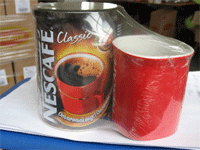 Shrink films used for packaging a variety of food products, cans, bottles, haberdashery and household products, newspapers, magazines, stationery, etc.
Shrink films used for packaging a variety of food products, cans, bottles, haberdashery and household products, newspapers, magazines, stationery, etc.
Possible options Shrink film packaging can be divided into three main groups: single, group and stack packaging.
Single packaging(it is called piece, or individual) - each individual product is wrapped in film, which, after shrinking, tightly fits the product, repeating its configuration.
Group packaging- a set of several similar or different types of products is pre-packaged, which, as with a single package, are wrapped in film, after shrinkage of which a dense package is obtained. Packaging can only be done in film or using preliminary placement of products on special substrates. This type of packaging can be used as a transport container
Stack packaging- products (bags, boxes, books, bricks, trays with cans, bottles, etc.) are placed on a rigid pallet in several rows, which are covered with a cover of shrink film and fed into a tunnel oven. After shrinking, a compact stack is obtained that can be easily moved by lifting vehicles. Stack packaging is a modern and promising type of transport packaging of goods.
The process of packaging in shrink film includes the following operations: laying the product on a substrate (tray, pallet); wrapping with film; package welding; shrinkage (passage through the shrink chamber); cooling of products.
Shrink film shells design are divided into wrapping, full wrapping and sheathing type.
Obanderolivayuschie packaging shells cover a group of products (packaging units) or a transport package (block package) completely around the perimeter, and have holes on the end sides.
When fully wrapped the film shell completely covers the transport package or group of products (packaging units).
For fastening transport packages with packaging shells sheath type Covers are made from tubular shrink film by joining the upper edges of a section of sleeve with a welded seam.
Printing on shrink film
If we talk about shrink film for group packaging, then it is quite thick and durable material. Printing is usually done on the front surface - unlike shrink labels. The gravure printing method is predominantly used, but flexography is also confidently gaining its space.
Flexographic and gravure printing methods are also used for printing on thin shrink films for small packaging.
Printing on shrink films presents challenges that are not typical for working with paper. Prepress preparation requires a special approach. It is necessary to design the image in such a way that when it shrinks on a product or group of products, for example, the same bottles, it does not turn out to be distorted. Here the “distorting mirror” effect must be calculated in advance. Special software products have already been created for this purpose.
Film shrinkage also affects the paint. The main thing is that the paint film remains flexible enough, otherwise after shrinkage, tears, cracks, and dark stripes will appear in places where pigment accumulates. Almost all quality paint manufacturers have overcome these problems.
Working with paints water based are faced with another problem. The bulk of such orders were traditionally carried out on gravure printing machines, but now more and more flexographic printing houses are offering printing with water-based inks. However, when the finished printed package is cured in a steam tunnel dryer, the ink may pick up moisture again.
Application of shrink film
According to the experience of foreign enterprises, 95% of shrink films are used for non-food products and only 5% for food products (most often for packaging pizza and vegetables). In our country, shrink films are widely used for packaging food products. Areas of application in food industry quite varied, the most common of which are the following:
Packaging of bakery products - used to increase sales time and, in addition, in such packaging bakery products acquire an aesthetic presentation;
Packaging of meat and poultry - to increase shelf life, give an aesthetic appearance and convenience for retail sales;
Packaging of confectionery or semi-finished products using trays of appropriate sizes. Such packaging, thanks to the rigid tray, ensures greater safety of the product compared to conventional packaging in bags and has a packaging volume that is more attractive to the consumer.
Group packaging of cans, bottles, bags of alcoholic and soft drinks, dairy products, etc.
Shrink film is also used in the field of non-food products. In particular, it is used to:
Packaging of paper products - fax paper, printing products. In this case, shrink films with a low degree of shrinkage are used;
Packaging of radio-electronic, metalworking and light industry;
Packaging of household products;
Packaging of chemical, food, medical, perfumery products;
Packaging building materials: skirting boards, glazing beads, platbands, cornices, blinds, wallpaper and many other long pieces. In this case, heat-shrinkable films with different shrinkage in the longitudinal and transverse directions are used;
Packaging of video cassettes, CDs, DVDs, souvenirs, etc.
Shrink films are also used for packaging products in brick and glass factories.
The physical, mechanical and operational properties of the films are determined by the chemical nature of the polymer used and the degree of its orientation.
Important characteristics of shrink films are shrinkage rate (shrinkage factor) and shrinkage stress . The degree of shrinkage is characterized by the ratio of the linear dimensions of the sample before and after shrinkage and is determined by the formula:
Kyс = (Lo - L/Lo)100%, where Lo and L are the length of the sample before and after shrinkage.
Shrinkage stress Sus- this stress that occurs in an oriented material when heated to a certain temperature is determined by the formula:
Sus = P/S, MPa, where P is the force generated during shrinkage; S - cross-sectional area of the sample after shrinkage.
The shrinkage voltage depends on the temperature and duration of heating of the film. The lower the shrink temperature, the longer it takes for the film to shrink. If shrinkage is carried out at high temperatures, the shrinkage time may be insignificant. The strength of the films after shrinkage decreases somewhat, but remains sufficient to ensure the integrity of the package.
For packaging single products of small mass, for example, baked goods, bird carcasses, aerosol cans, souvenir sets, films with a thickness of 20 - 50 microns are used, for group packaging a film with a thickness of 50 - 100 microns is selected, for packaging on pallets (stack packaging) - a film with a thickness of 100 - 250 microns.
The table shows the main properties of some shrink films
| Polymer | Shrinkage rate,% | Shrinkage stress, MPa | Shrinkage temperature during packaging, °C | Welding temperature, °C |
| LDPE | 15-50 | 0,3-3,5 | 120-150 | 150-200 |
| PP | 70-80 | 2,0-4,0 | 150-230 | 175-200 |
| PVC | 50-70 | 1,0-2,0 | 110-155 | 135-175 |
| VHVD | 30-60 | 1,0-1,5 | 95-140 | 200-315 |
| PS | 40-60 | 0,7-4,0 | 130-160 | 120-150 |
| Escaplen | 30-50 | 1,0-2,5 | 100-150 | 180-250 |
To achieve high physical, mechanical and technological characteristics of shrink film as a packaging material, the following requirements are imposed on it: formulation, high uniformity of properties over the entire field of the web, high quality of winding.
Packaging options and areas of application of shrink film
Shrink films used for packaging a variety of food products, cans, bottles, haberdashery and household products, newspapers, magazines, stationery, etc.
Possible options for packaging in shrink film can be divided into three main groups: single, group and stack packaging.
Single packaging(it is called piece, or individual) - each individual product is wrapped in film, which, after shrinking, tightly fits the product, repeating its configuration.
Group packaging- a set of several similar or different types of products is pre-packaged, which, as with a single package, are wrapped in film, after shrinkage of which a dense package is obtained. Packaging can only be done in film or using preliminary placement of products on special substrates. This type of packaging can be used as a transport container
Stack packaging- products (bags, boxes, books, bricks, trays with cans, bottles, etc.) are placed on a rigid pallet in several rows, which are covered with a cover of shrink film and fed into a tunnel oven. After shrinking, a compact stack is obtained that can be easily moved by lifting vehicles. Stack packaging is a modern and promising type of transport packaging of goods.
The process of packaging in shrink film includes the following operations: laying the product on a substrate (tray, pallet); wrapping with film; package welding; shrinkage (passage through the shrink chamber); cooling of products.
Shrink film shells according to their design are divided into: wrapping, full wrapping and sheathing type.
Obanderolivayuschie packaging shells cover a group of products (packaging units) or a transport package (block package) completely around the perimeter, and have holes on the end sides.
When fully wrapped the film shell completely covers the transport package or group of products (packaging units).
For fastening transport packages with packaging shells sheath type Covers are made from tubular shrink film by joining the upper edges of a section of sleeve with a welded seam.
Printing on shrink film
If we talk about shrink film for group packaging, it is a fairly thick and durable material. Printing is usually done on the front surface - unlike shrink labels. The gravure printing method is predominantly used, but flexography is also confidently gaining its space.
Flexographic and gravure printing methods are also used for printing on thin shrink films for small packaging.
Printing on shrink films presents challenges that are not typical for working with paper. Prepress preparation requires a special approach. It is necessary to design the image in such a way that when it shrinks on a product or group of products, for example, the same bottles, it does not turn out to be distorted. Here the “distorting mirror” effect must be calculated in advance. Special software products have already been created for this purpose.
Film shrinkage also affects the paint. The main thing is that the paint film remains flexible enough, otherwise after shrinkage, tears, cracks, and dark stripes will appear in places where pigment accumulates. Almost all quality paint manufacturers have overcome these problems.
Those working with water-based paints face a different problem. The bulk of such orders were traditionally carried out on gravure printing machines, but now more and more flexographic printing houses are offering printing with water-based inks. However, when the finished printed packaging is cured in a steam tunnel dryer, the ink may pick up moisture again.
Application of shrink film
According to the experience of foreign enterprises, 95% of shrink films are used for non-food products and only 5% for food products (most often for packaging pizza and vegetables). In our country, shrink films are widely used for packaging food products. Its areas of application in the food industry are quite diverse, the most common of which are the following:
Packaging of bakery products - used to increase sales time and, in addition, in such packaging bakery products acquire an aesthetic presentation;
Packaging of meat and poultry - to increase shelf life, give an aesthetic appearance and convenience for retail sale;
Packaging of confectionery or semi-finished products using trays of appropriate sizes. Such packaging, thanks to the rigid tray, ensures greater safety of the product compared to conventional packaging in bags and has a packaging volume that is more attractive to the consumer.
Group packaging of cans, bottles, bags of alcoholic and soft drinks, dairy products, etc.
Shrink film is also used in the field of non-food products. In particular, it is used to:
Packaging of paper products – fax paper, printing products. In this case, shrink films with a low degree of shrinkage are used;
Packaging of radio-electronic, metalworking and light industry products;
Packaging of household products;
Packaging of chemical, food, medical, perfumery products;
Packaging of building materials: skirting boards, glazing beads, platbands, cornices, blinds, wallpaper and many other long items. In this case, heat-shrinkable films with different shrinkage in the longitudinal and transverse directions are used;
Packaging of video cassettes, CDs, DVDs, souvenirs, etc.
Shrink films are also used for packaging products in brick and glass factories.
by AD MIN
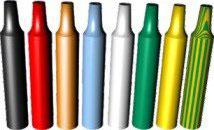
general information
The main property of heat shrink tube is the ability to change its diameter (shrink) under the influence of high temperature(70 to 120 °C). When shrinking, the tube tightly encloses the object and thereby provides mechanical or insulating protection. The ability to shrink, high mechanical strength and electrical insulating properties allow the tubes to be used in radio electronics, the automotive industry for insulating conductors and electrical wires, protection of terminals and interfaces between connectors and wires, protection against corrosion metal pipes and fittings, antenna equipment. The main material for the production of tubes is polyolefin.
What are heat shrink tubing for? More recently, heat-shrinkable tubing was used only in high-tech industries: aviation, space, nuclear. But in Lately tubes have become in demand in other market segments: energy, electronics, instrument making. Interest in heat-shrinkable tubing is due to its economic performance and ease of use. The scope of application of tubes is extremely high. Let's list some of them:
- Creation of a durable electrical insulating layer on elements of various shapes.
- Sealing and protection against mechanical stress and corrosion.
- Color coding.
- Tying of tourniquets.
- Protecting kinks and preventing deformation.
In addition, tubes are also used as decorative element, fortunately, the color range of manufactured products allows. For professional activities it is better to use industrial dryer allowing shrinkage to be carried out accurately and evenly. But, in as a last resort, a regular lighter will do, or gas-burner. The process itself is very fast, which allows you to use heat shrink tubing as an alternative to electrical tape.
Types of tubes
Heat shrink tubing differs in many ways. In order to choose the right tube correctly, you need to understand their features. The most important characteristics are the following:
- Shrinkage ratio: can vary from 2:1 to 6:1
- Presence of an adhesive layer
- Color spectrum. The most common are basic standard colors and combinations of two colors, for example (yellow/green).
- Polymer composition: polyolefins, elastomers, fluorine polymers, PVC, fluorine rubbers and other options.
- Resistance to aggressive environments: heat-resistant, chemical-resistant, oil- and petrol-resistant, with photoluminescence effect, light-stabilized.
How to use heat shrink tubing
The tubing installation process is extremely simple and does not require special tool and skills. Moreover, using the tube will take less time than using insulating tapes.
First, the required tube diameter is selected. It is necessary to ensure that the minimum diameter of the product is greater than the diameter of the tube after complete shrinkage. For example, for a wire with a diameter of 3.5 mm, you can use tubes with a diameter before shrinkage of 4.8 mm (maximum after shrinkage - 2.4 mm) or 6.4 mm (maximum after shrinkage - 3.2 mm).
Once you have decided on the diameter of the tube, cut a piece of it to the required length. Make sure that the cut is smooth, without burrs, otherwise, when shrinking, a rupture may occur in the place of the uneven cut.
Place a piece of tubing over the area that needs to be insulated. Next, the shrinkage process itself begins. For this purpose, it is preferable to use a hot air gun. You can also use a regular lighter, torch, etc. suitable tools. Shrinkage is carried out in two ways - either starting from one edge to the other, or from the middle to the edges.
The optimal shrinkage temperature is selected empirically or ask the seller. There is no point in exceeding the temperature, since increasing it will not affect the shrinkage rate. It is also important to ensure uniform heating of the tube. Overheating of the heat shrink tube leads to defects - bubbles, charring, rupture.
Heat shrink tubing brands
There are several common brands of heat shrink tubing available on the market today. They differ from each other in technical characteristics.
Medium wall heat shrinkable tubes series MDT-A are used for insulation and sealing of connections of all types of cables with plastic and impregnated paper insulation laid in open electrical installations.
Main advantages of MDT-A tubes:
- Heat-shrinkable tubes are made from a modified self-extinguishing polyolefin with high aging resistance
- Resistant to ultraviolet radiation and exposure to chemicals
- Hot-melt adhesive that covers inner surface tubes, fills all irregularities and voids, ensuring high tightness
Parameters of MDT-A tubes
|
Delivered length, mm |
Inner diameter | Wall thickness | product name | ||
| Before shrinkage, mm | After free shrinkage, mm | Before shrinkage, mm | After free shrinkage, mm | ||
| 1000 | 12 | 3 | 0,7 | 2,5 | MDT-A 12/3 |
| 1000 | 19 | 6 | 0,8 | 3,3 | MDT-A 19/6 |
| 1000 | 27 | 8 | 0,8 | 3,3 | MDT-A 27/8 |
| 1000 | 32 | 7,5 | 0,8 | 3,3 | MDT-A 32/7.5 |
| 1000 | 38 | 12 | 0,8 | 3,3 | MDT-A 38/12 |
| 1000 | 50 | 18 | 0,8 | 3,3 | MDT-A 50/18 |
| 1000 | 70 | 26 | 0,8 | 3,3 | MDT-A 70/26 |
| 1000 | 90 | 36 | 0,8 | 3,3 | MDT-A 90/36 |
| 1000 | 120 | 40 | 0,8 | 3,3 | MDT-A 120/40 |
Material characteristics:
|
Parameter |
Unit | Meaning |
| Shrinkage rate | - | 4,5:1 |
| Longitudinal shrinkage | % | - 10 max. |
| Shrinkage temperature | 0C | >135 |
| Working temperature | 0C | 110 |
| Density | g/cm3 | 1 |
| Elongation at break | % | 500 |
| Tensile strength | MPa | >10 |
| Moisture capacity | % | <0,5 |
| Specific volumetric resistance of insulation | Ohm*cm | 1014 |
| Breakdown resistance | kV/mm | 11 |
| Flammability | - | non-self-extinguishing |
It is advisable to heat the heat-shrinkable tube from the middle to the edges to prevent the formation of air gaps. This is especially true for long tubes and tubes with an adhesive layer.
- Heat-shrinkable tubes shrink not only in diameter, but also in length. This must be taken into account when measuring segments of the required length. Longitudinal shrinkage can be minimized by heating the tube from edge to edge.
- If the product on which the tube is shrinking is made of a material with high thermal conductivity (for example, metal), when shrinking the tube, it is necessary to preheat the product to avoid the formation of “cold scars” and for a more dense shrinkage of the tube.
- When cutting the tube, the edges should be smooth, without burrs.
- The size of the tube must be selected according to the following principle: the diameter of the product on which the tube is seated must be 20% greater than the minimum diameter of the tube and 20% less than its maximum diameter.
- The higher the temperature of the heating source, the faster the tube will shrink.
The full range of 3M heat shrink tubing is presented in the online store category
Economical heat-shrinkable polyolefin tubing. Polyolefin heat shrink is the simplest and most reliable solution for insulation, electrical insulation, protection, color identification in a wide variety of industries. Meets fire safety requirements of FMVSS 302 standard (for the automotive industry).
Technical features
- Operating temperatures from -55°С to +105°С
- Shrinkage temperature from +125°С to +200°С
- Heat resistance class - A (VDE 0530)
- Halogen free
Standard colors
- white
- black
- transparent
- violet
- red
- yellow
- green
- grey
- blue
- brown
- dark green (NATO green)
Characteristics
| Tensile breaking force | IEC-60684-2 | 16.5 MPa |
| Elongation before breaking | IEC-60684-2 | 410% |
| Longitudinal shrinkage | ASTM-D 2671 | to 10% |
| Specific Gravity | ASTM-D 792, A-I | 0.95 g/cm 3 |
| Elongation after heat exposure (168 hours at 150°C) | IEC-811-1-2 | 429% |
| Breaking force after thermal exposure (168 hours at 150°C) | IEC-811-1-2 | 15.9 MPa |
| Elongation after thermal shock (4 hours at 200°C) | IEC-811-1-2 | 400% |
| Breaking force after thermal shock (4 hours at 200°C) | IEC-811-1-2 | 15 MPa |
| Flexibility at low temperatures | ASTM-D 2671 Method C. | no cracking at -55°C |
| Flammability | FMVSS-302 | corresponds |
| Corrosion resistance | ASTM-D 2671 Method A. | does not corrode |
| Copper corrosion | ASTM-D 2671 Method B. | does not corrode |
| Chemical resistance | - | persistent |
| Water absorption | VDE 0472 | up to 0.3% |
| Volume resistivity | VDE 0303 part 3 | 10 14 Ohm/cm |
| Electric strength | VDE 0303 part 2 | 20 kV/mm |
Our store offers more than a hundred items in a variety of sizes and colors.
TCT brand heat-shrinkable tubes are a successful alternative to PBF tubes and have a number of advantages over PBF tubes. The main one is the low shrinkage temperature (from + 70°C), which is, for example, very important when radio-electronic components and other materials are sensitive to heat, and also allows you to increase the shrinkage rate and achieve impressive energy savings. In addition, the material of this type of tube suppresses combustion.
Flame suppression tubes
Flame suppression means the inability of the tubes to maintain combustion, to go out on their own in the absence of an open flame, as well as the inability to self-ignite. To do this, specially developed non-flammable additives are added to the tube material. Such heat-shrinkable tubes with fire suppression are especially relevant in those areas where there is a high probability of equipment fire: aviation industry, shipbuilding, explosive industries, etc.
General Specifications of TCT Tube
- Operating temperature: -55°C to +125°C
- Shrinkage temperature: Start at 70°C, complete shrinkage at 115°C
- Existing sizes:
- Diameter from 0.8 - to 180 mm
- Shrinkage ratio: 2:1
Available colors:
- black,
- red,
- yellow,
- green,
- violet,
- grey,
- blue,
- transparent,
- yellow-green,
- white, etc.
The full range is available in the "




